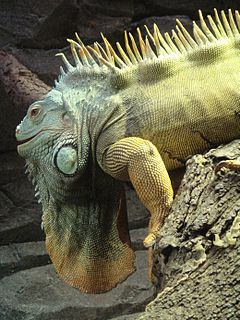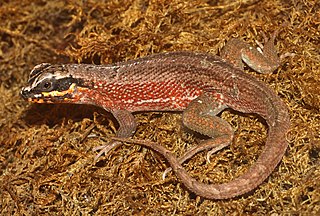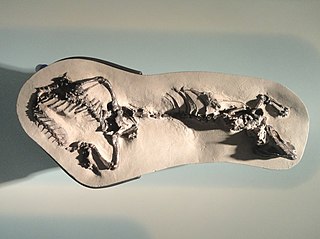
The Lepidosauria are reptiles with overlapping scales. This subclass includes Squamata and Rhynchocephalia. It is a monophyletic group and therefore contains all descendants of a common ancestor. Squamata includes snakes, lizards, and amphisbaenia. Rhynchocephalia was a widespread and diverse group 220-100 million years ago; however, it is now represented only by the genus Sphenodon, which contains a single species of tuatara, native to New Zealand. Lepidosauria is the sister taxon to Archosauria, which includes Aves and Crocodilia. Lizards and snakes are the most speciose group of lepidosaurs and, combined, contain over 9,000 species. There are many noticeable distinguishing morphological differences between lizards, tuataras, and snakes.

Squamata is the largest order of reptiles, comprising lizards, snakes and amphisbaenians, which are collectively known as squamates or scaled reptiles. With over 10,900 species, it is also the second-largest order of extant (living) vertebrates, after the perciform fish. Members of the order are distinguished by their skins, which bear horny scales or shields. They also possess movable quadrate bones, making it possible to move the upper jaw relative to the neurocranium. This is particularly visible in snakes, which are able to open their mouths very wide to accommodate comparatively large prey. Squamata is the most variably sized order of reptiles, ranging from the 16 mm (0.63 in) dwarf gecko to the 5.21 m (17.1 ft) green anaconda and the now-extinct mosasaurs, which reached lengths of over 14 m (46 ft).

Amphisbaenia is a group of usually legless squamates, comprising over 200 extant species. Amphisbaenians are characterized by their long bodies, the reduction or loss of the limbs, and rudimentary eyes. As many species have a pink body and scales arranged in rings, they have a superficial resemblance to earthworms. While the genus Bipes retains forelimbs, all other genera are limbless. Although superficially similar to the snakes and blind lizards, recent phylogenetic studies suggest that they are most closely related to the true lizards. Amphisbaenians are widely distributed, occurring in North America, Europe, Africa, South America, Western Asia and the Caribbean. They are not found east of the Caspian Sea. Most species are less than 6 inches (150 mm) long.

The Iguanidae are a family of lizards composed of iguanas and related species.

Dibamidae or blind skinks is a family of lizards characterized by their elongated cylindrical body and an apparent lack of limbs. Female dibamids are entirely limbless and the males retain small flap-like hind limbs, which they use to grip their partner during mating. They have a rigidly fused skull, lack pterygoid teeth and external ears. Their eyes are greatly reduced, and covered with a scale.

Toxicofera is a proposed clade of scaled reptiles (squamates) that includes the Serpentes (snakes), Anguimorpha and Iguania. Toxicofera contains about 4,600 species, of extant Squamata. It encompasses all venomous reptile species, as well as numerous related non-venomous species. There is little morphological evidence to support this grouping, however it has been recovered by all molecular analyses as of 2012.

Iguania is an infraorder of squamate reptiles that includes iguanas, chameleons, agamids, and New World lizards like anoles and phrynosomatids. Using morphological features as a guide to evolutionary relationships, the Iguania are believed to form the sister group to the remainder of the Squamata, and comprise nearly 13,000 named species. However, molecular information has placed Iguania well within the Squamata as sister taxa to the Anguimorpha and closely related to snakes. The order has been under debate and revisions after being classified by Charles Lewis Camp in 1923 due to difficulties finding adequate synapomorphic morphological characteristics. The majority of Iguanias are arboreal but there are several terrestrial groups. They usually have primitive fleshy, non-prehensile tongues, although the tongue is highly modified in chameleons. The group has a fossil record that extends back to the Early Jurassic. Today they are scattered occurring in Madagascar, the Fiji and Friendly Islands and Western Hemisphere

Pythonomorpha was originally proposed by paleontologist Edward Drinker Cope (1869) as a reptilian order comprising mosasaurs, which he believed to be close relatives of Ophidia (snakes). The etymology of the term Pythonomorpha comes from the Greek Python and morphe ("form"), and refers to the generally serpentine body plan of members of the group. Cope wrote, "In the mosasauroids, we almost realize the fictions of snake-like dragons and sea-serpents, in which men have been ever prone to indulge. On account of the ophidian part of their affinities, I have called this order Pythonomorpha." Cope incorporated two families, the Clidastidae and the Mosasauridae.

Gekkota is an infraorder of squamate reptiles in the suborder Scleroglossa, comprising all geckos and the limbless "snake-lizards" of family Pygopodidae. The legless lizards of the family Dibamidae, also referred to as blind lizards, have occasionally been counted as gekkotans, but recent molecular phylogenies suggest otherwise.

The Alethinophidia are an infraorder of snakes that includes all snakes other than blind snakes and thread snakes. Snakes have long been grouped into families within Alethinophidia based on their morphology, especially that of their teeth. More modern phylogenetic hypotheses using genetic data support the recognition of 19 extant families, although the taxonomy of alethinophidian snakes has long been debated, and ultimately the decision whether to assign a particular clade to a particular Linnaean rank is arbitrary.

Scleroglossa is a clade of lizards that includes geckos, autarchoglossans, and amphisbaenians. Scleroglossa is supported by phylogenetic analyses that use morphological features. According to most morphological analyses, Scleroglossa is the sister group of the clade Iguania, which includes iguanas, chameleons, agamids, and New World lizards. Together, Scleroglossa and Iguania make up crown group Squamata, the smallest evolutionary grouping to include all living lizards and snakes.

Platynota is a group of anguimorph lizards and thus belongs to the order Squamata of the class Reptilia. Since it was named in 1839, it has included several groups, including monitor lizards, snakes, mosasaurs, and helodermatids. Its taxonomic use still varies, as it is sometimes considered equivalent to the group Varanoidea and other times viewed as a distinct group. It is phylogenetically defined as a clade containing Varanidae. It also includes many extinct species.

Polyglyphanodontia, also known as the Borioteiioidea, is an extinct clade of lizards from the Cretaceous that includes around a dozen genera. Polyglyphanodontians were the dominant group of lizards in North America and Asia during the Late Cretaceous. Most polyglyphanodontians are Late Cretaceous in age, though the oldest one, Kuwajimalla kagaensis, is known from the Early Cretaceous Kuwajima Formation (Japan). Early Cretaceous South American taxon Tijubina, and possibly also Olindalacerta, might also fall within Polyglyphanodontia or be closely allied to the group, but if so, they would be two of only three Gondwanan examples of an otherwise Laurasian clade. They produced a remarkable range of forms. Chamopsiids, including Chamops, were characterized by large, blunt, crushing teeth, and were most likely omnivores. Macrocephalosaurus, from the Gobi Desert, was a specialized herbivore; it grew to roughly a meter long and had multicusped, leaf-shaped teeth like those of modern iguanas. Polyglyphanodon, from the Maastrichtian of Utah, was another herbivore, but its teeth formed a series of transverse blades, similar to those of Trilophosaurus. Peneteius had remarkable, multicusped teeth, similar to those of mammals. The polyglyphanodontids first appear in the latter part of the Early Cretaceous in North America, and became extinct during the Cretaceous-Paleogene extinction event. Polyglyphanodontians closely resembled the teiid lizards, and purported teiid lizards from the Late Cretaceous appear to be polyglyphanodontians. The only species known to have survived the Cretaceous was Chamops, which survived until the very early Ypresian.
Myrmecodaptria is an extinct genus of scleroglossan lizard from the Late Cretaceous Djadokhta Formation in Ukhaa Tolgod, Mongolia. The type and only species, Myrmecodaptria microphagosa, was named in 2000 by paleontologists Gao Keqin and Mark Norell. Myrmecodaptria is known from a single holotype skull and lower jaws. It is distinguished from all other lizards by its extremely elongated skull. The eyes are placed close to the snout, which is short and rounded. The top of the skull is covered in bony knobs called osteoderms. The parietal bone at the back of the skull is elongated and about as long as the frontal bones, which are the usually the longest bones along the top of the skull in lizards. The squamosal bone at the back of the skull reaches forward to connect with the jugal bone behind the eye, forming a thin arch between the temporal fenestrae. Myrmecodaptria also has fewer and more widely spaced teeth in its jaws than do most other lizards.
Lepidosaur herbivory describes herbivorous lepidosaurs. Living non-avian reptiles form a paraphyletic group that consists of over 9,000 species of crocodiles, turtles, and lepidosaurs. The most diverse group, Lepidosauria, is first known from the Middle Triassic fossils, but likely originated in the Permian. Living lepidosaurs, which include snakes, lizards, and rhynchocephalians, occupy a wide range of environments and niches.The lepidosaurs have many similar anatomical morphology like transverse cloaca, distal tongue, superficial teeth attachment, fused pelvic bones etc. Though widely viewed as obligate carnivores, a small number of lepidosaurs are known to consume plant material. For example, there are roughly 3,300 species of living lizards and approximately 3% of them eat at least some plants. Though the exact definition of herbivory varies significantly between scientists, most define herbivorous lepidosaurs as those that consume plants for approximately 70-90% of its diet.

Neoanguimorpha is a clade of anguimorphs comprising Monstersauria and Diploglossa. Morphological studies in the past had classified helodermatids with the varanoids in the clade Platynota, while the Chinese crocodile lizard was classified as a xenosaurid. However molecular work found no support in these groupings and instead has found the helodermatids more related to Diploglossa, while the Chinese crocodile lizard and varanoids to form the clade Paleoanguimorpha.

Paleoanguimorpha is a clade of anguimorphs comprising Shinisauria and Goannasauria. Morphological studies in the past also classified helodermatids and pythonomorphs with the varanoids in the clade Platynota, while the Chinese crocodile lizard was classified as a xenosaurid. Current molecular work finds no support in these groupings and instead has found the helodermatids more related to Diploglossa in the sister clade Neoanguimorpha, while the Chinese crocodile lizard is the closet living relative to varanoids. Pythonomorphs represented by snakes today are not closely related to varanoids and are instead a sister lineage to Anguimorpha and Iguania in the clade Toxicofera.

Diploglossa is a clade of neoanguimorphs represented by the families Xenosauridae, Diploglossidae, Anniellidae and Anguidae, the latter three placed in the superfamily Anguioidea. In the past the Chinese crocodile lizard was classified as a xenosaurid; current molecular work has shown evidence the species related to varanoids in the clade Paleoanguimorpha.

Pygopodoidea is a gecko superfamily and the only taxon in the gekkotan subclade Pygopodomorpha. The clade includes three Australasian families: Diplodactylidae, Carphodactylidae, and Pygopodidae. Traditional gekkotan systematics had considered Diplodactylidae and Carphodactylidae as subfamilies of the family Gekkonidae, but recent molecular work have placed Pygopodidae within Gekkonidae making it paraphyletic. These analyses have shown support of Pygopodidae and Carphodactylidae being sister taxa, with Diplodactylidae occupying a basal position in Pygopodoidea.

The Colubroides are a clade in the suborder Serpentes (snakes). It contains over 85% of all the extant species of snakes. The largest family is Colubridae, but it also includes at least six other families, at least four of which were once classified as "Colubridae" before molecular phylogenetics helped us understand their relationships. It has been found to be monophyletic.


















